UK shoes come in up to nine different widths. Shoe widths range from AAA, which is the narrowest available size, to EEE, which is the widest size. To make sure that you wear comfortable, properly fitting shoes, it’s important to get your width right. On this page you will find shoe width charts, information on how to measure, and help to find proper fitting shoes easily.
UK Shoe Width Chart
| UK Size | Narrow | Medium | Wide | Extra-Wide |
|---|---|---|---|---|
| 3 | 7.2 cm | 8.1 cm | 9 cm | 10 cm |
| 4 | 7.5 cm | 8.5 cm | 9.4 cm | 10.3 cm |
| 5 | 7.9 cm | 8.8 cm | 9.7 cm | 10.6 cm |
| 6 | 8.3 cm | 9 cm | 10 cm | 11 cm |
| 7 | 8.6 cm | 9.4 cm | 10.3 cm | 11.3 cm |
| 8 | 8.8 cm | 9.7 cm | 10.6 cm | 11.6 cm |
| 9 | 9.1 cm | 10 cm | 11 cm | 11.9 cm |
| 10 | 9.6 cm | 10.3 cm | 11.2 cm | 12.3 cm |
| 11 | 9.7 cm | 10.6 cm | 11.6 cm | 12.7 cm |
| 12 | 9.9 cm | 10.9 cm | 12 cm | 13.1 cm |
| 13 | 10.2 cm | 11.2 cm | 12.4 cm | 13.5 cm |
How To Measure Shoe Width Yourself
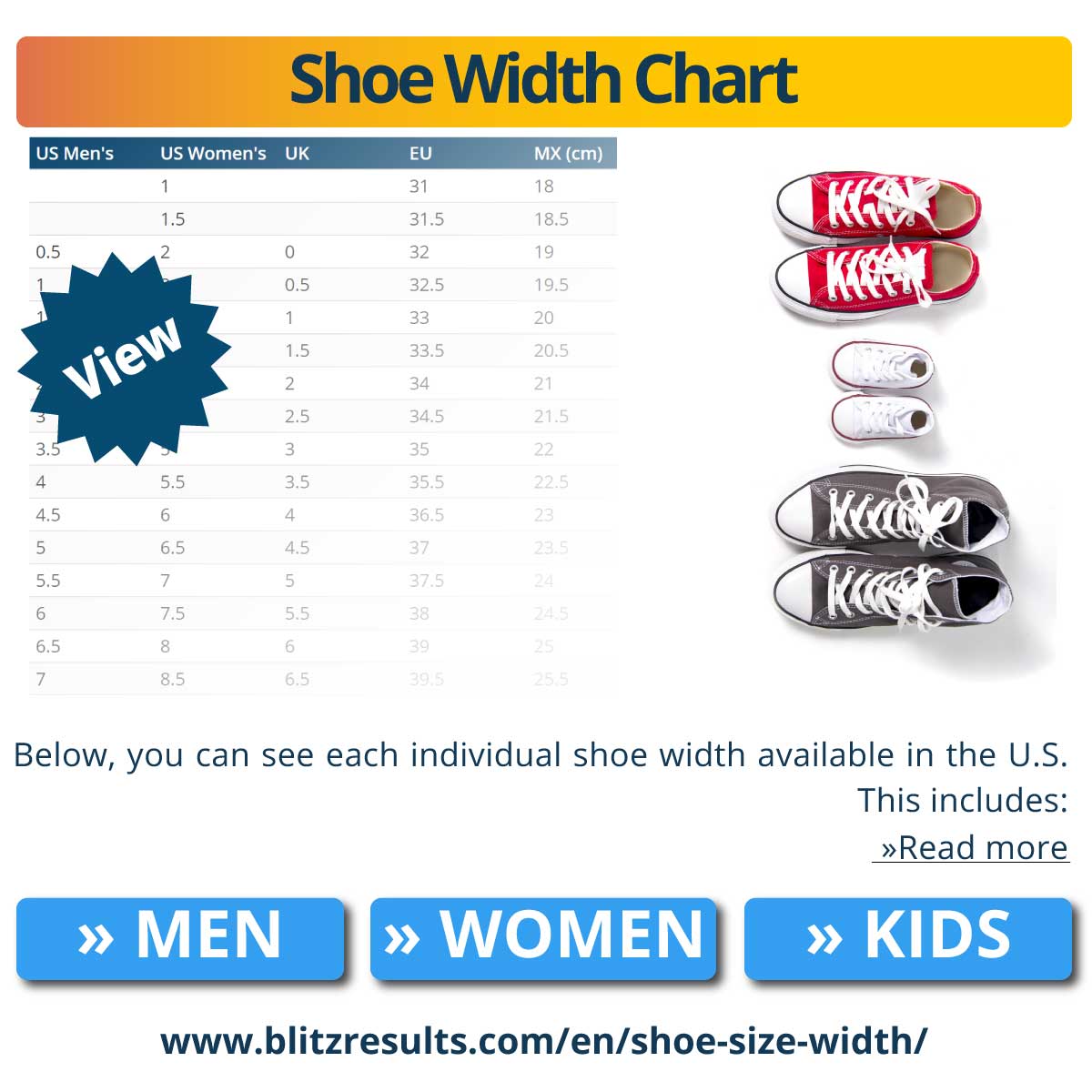
If you can’t visit a shoe store, you can measure your shoe width yourself. Take off your socks, and make sure you measure both feet – one can be wider than the other.
1. Use a soft tape measure and wrap it around the widest part of your foot. Do not tighten it too much. Put your foot on the ground, and distribute your weight as you normally would when standing.
2. Next, mark on the tape measure how many millimeters wide your foot is.
3. Look up your width on the above shoe tables.
Don’t have a tape measure? You can use a length of string. Just mark the string, and then use a ruler to identify its width!
Men’s Shoe Width Chart
| US Size | Narrow (C) | Average (D) | Wide (E) |
|---|---|---|---|
| 6 | 3 5⁄16" | 3 1⁄2" | 3 11⁄16" |
| 6.5 | 3 5⁄16" | 3 5⁄8" | 3 3⁄4" |
| 7 | 3 3⁄8" | 3 5⁄8" | 3 3⁄4" |
| 7.5 | 3 3⁄8" | 3 11⁄16" | 3 15⁄16" |
| 8 | 3 1⁄2" | 3 3⁄4" | 3 15⁄16" |
| 8.5 | 3 5⁄8" | 3 3⁄4" | 4" |
| 9 | 3 5⁄8" | 3 15⁄16" | 4 1⁄8" |
| 9.5 | 3 11⁄16" | 3 15⁄16" | 4 1⁄8" |
| 10 | 3 3⁄4" | 4" | 4 3⁄16" |
| 10.5 | 3 3⁄4" | 4 1⁄8" | 4 5⁄16" |
| 11 | 3 14⁄16" | 4 1⁄8" | 4 6⁄16" |
| 11.5 | 3 14⁄16" | 4 3⁄16" | 4 8⁄16" |
| 12 | 3 14⁄16" | 4 4⁄16" | 4 10⁄16" |
| 12.5 | 3 15⁄16" | 4 5⁄16" | 4 10⁄16" |
| 13 | 4" | 4 6⁄16" | 4 12⁄16" |
| 13.5 | 4 1⁄16" | 4 7⁄16" | 4 13⁄16" |
| 14 | 4 2⁄16" | 4 8⁄16" | 4 14⁄16" |
| 14.5 | 4 3⁄16" | 4 9⁄16" | 4 14⁄16" |
| 15 | 4 4⁄16" | 4 10⁄16" | 4 14⁄16" |
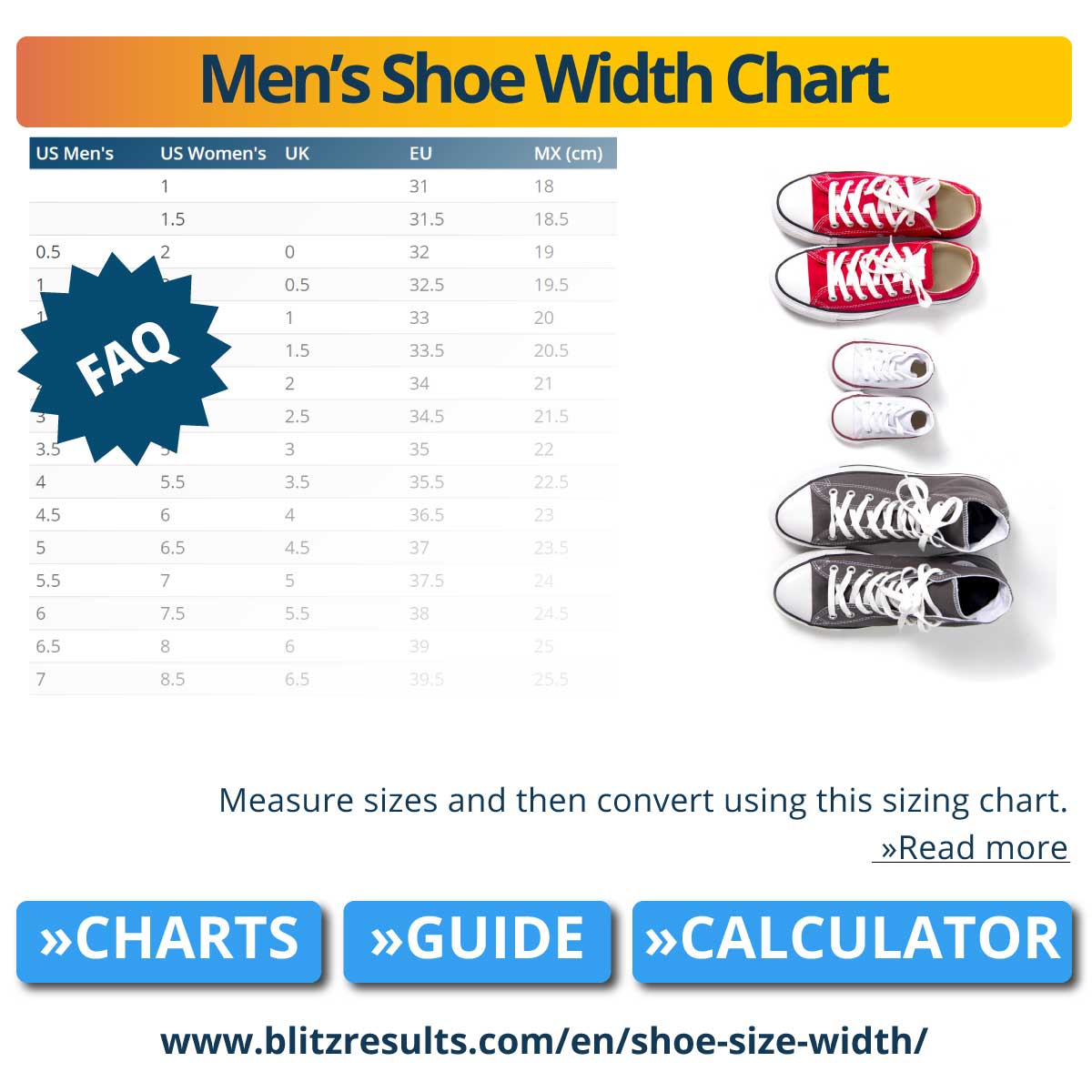
D-width is a medium for men, and a wide size for women. E widths are considered to be wide for men, and extra-wide for women. EE width shoes are extra wide for both men and women, and used to be harder to find for women, though more companies have introduced EE women’s shoes in recent decades.
Men’s Shoe Size Letters
| Letter | Width | Abbreviation |
|---|---|---|
| B | Narrow | N |
| D | Medium or Average | M or A |
| 2E or EE | Wide | W |
| 4E or EEEE | Extra-Wide | WW or XW or EW |
Women’s Shoe Width Chart
| US Size | Narrow (AA) | Average (B) | Wide (C/D) | Extra-Wide (E) |
|---|---|---|---|---|
| 5 | 2 13/16" | 3 3/16" | 3 9/16" | 3 15/16" |
| 5.5 | 2 7/8" | 3 1/4" | 3 5/8" | 4" |
| 6 | 2 15/16" | 3 5/16" | 3 11/16" | 4 1/16" |
| 6.5 | 3" | 3 3/8" | 3 3/4" | 4 1/8" |
| 7 | 3 1/16" | 3 7/16" | 3 13/16" | 4 3/16" |
| 7.5 | 3 1/8" | 3 1/2" | 3 7/8" | 4 1/4" |
| 8 | 3 3/16" | 3 9/16" | 3 15/16" | 4 5/16" |
| 8.5 | 3 1/4" | 3 5/8" | 4" | 4 3/8" |
| 9 | 3 3/8" | 3 11/16" | 4 1/16" | 4 7/16" |
| 9.5 | 3 3/8" | 3 3/4" | 4 1/8" | 4 1/2" |
| 10 | 3 7/16" | 3 3/4" | 4 3/16" | 4 9/16" |
| 10.5 | 3 1/2" | 3 7/8" | 4 1/4" | 4 5/8" |
| 11 | 3 9/16" | 3 15/16" | 4 5/16" | 4 11/16" |
| 12 | 3 11/16" | 4 1/16" | 4 7/16" | 4 13/16" |
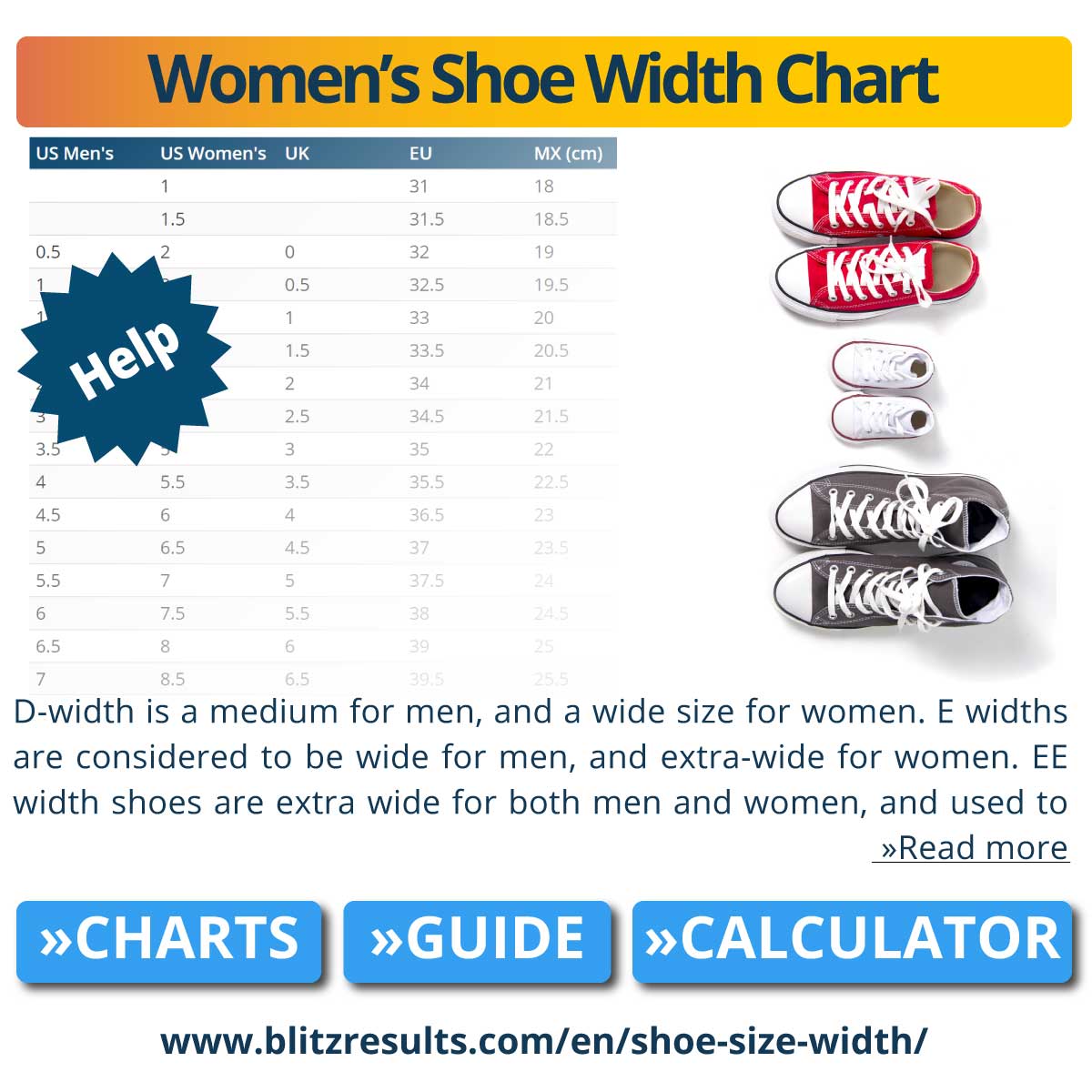
What’s The Difference Between Men’s And Women’s Widths? Men usually have wider feet, so the “medium” width for a man is a “D.” Women’s feet are typically smaller and narrower, so the “medium” width for a woman is a “B”. A “D” would be considered a wide shoe for women. Take a look at the charts on this page for more details about how width varies based on gender.
Women’s Shoe Size Letters
| Letter | Width | Abbreviation |
|---|---|---|
| 4A or AAAA | Super-Slim (Extra-Narrow) | SS, ES |
| 2A or AA | Narrow | N |
| B | Medium or Average | M or A |
| D | Wide | W |
| 2E or EE | Extra-Wide | WW or XW or EW |
Children’s Shoe Size Width
| US Size | Average (B) | Wide (D) | Extra-Wide (E) |
|---|---|---|---|
| 1 | 1 7/8" | 2 1/4" | 2 7/16" |
| 1.5 | 1 7/8" | 2 1/4" | 2 7/16" |
| 2 | 2" | 2 3/8" | 2 9/16" |
| 2.5 | 2" | 2 3/8" | 2 9/16" |
| 3 | 2 1/8" | 2 7/16" | 2 5/8" |
| 3.5 | 2 1/8" | 2 7/16" | 2 5/8" |
| 4 | 2 3/16" | 2 9/16" | 2 3/4" |
| 4.5 | 2 3/16" | 2 9/16" | 2 3/4" |
| 5 | 2 1/4" | 2 5/8" | 2 13/16" |
| 5.5 | 2 1/4" | 2 11/16" | 2 7/8" |
| 6 | 2 5/16" | 2 3/4" | 2 15/16" |
| 6.5 | 2 3/8" | 2 3/4" | 2 15/16" |
| 7 | 2 7/16" | 2 13/16" | 3" |
| 7.5 | 2 1/2" | 2 7/8" | 3 1/16" |
| 8 | 2 1/2" | 2 15/16" | 3 1/16" |
| 8.5 | 2 9/16" | 3" | 3 3/16" |
| 9 | 2 5/8" | 3" | 3 3/16" |
| 9.5 | 2 11/16" | 3 1/16" | 3 1/4" |
| 10 | 2 3/4" | 3 1/8" | 3 5/16" |
| 10.5 | 2 3/4" | 3 3/16" | 3 3/8" |
| 11 | 2 13/16" | 3 1/4" | 3 1/2" |
| 11.5 | 2 7/8" | 3 5/16" | 3 1/2" |
| 12 | 2 15/16" | 3 3/8" | 3 9/16" |
| 12.5 | 3" | 3 7/16" | 3 5/8" |
| 13 | 3 1/16" | 3 1/2" | 3 11/16" |
| 13.5 | 3 1/8" | 3 9/16" | 3 3/4" |
| 1Y | 3 3/16" | 3 5/8" | 3 3/16" |
| 1.5Y | 3 1/4" | 3 11/16" | 3 7/8" |
| 2Y | 3 5/16" | 3 3/4" | 3 15/16" |
| 2.5Y | 3 3/8" | 3 13/16" | 4" |
| 3Y | 3 7/16" | 3 7/8" | 4 1/16" |
| 3.5Y | 3 1/2" | 3 15/16" | 4 1/16" |
| 4Y | 3 9/16" | 4" | 4 3/16" |
| 4.5Y | 3 5/8" | 4 1/16" | 4 1/4" |
| 5Y | 3 11/16" | 4 1/8" | 4 5/16" |
| 5.5Y | 3 3/4" | 4 3/16" | 4 3/8" |
| 6Y | 3 3/16" | 4 1/4" | 4 7/16" |
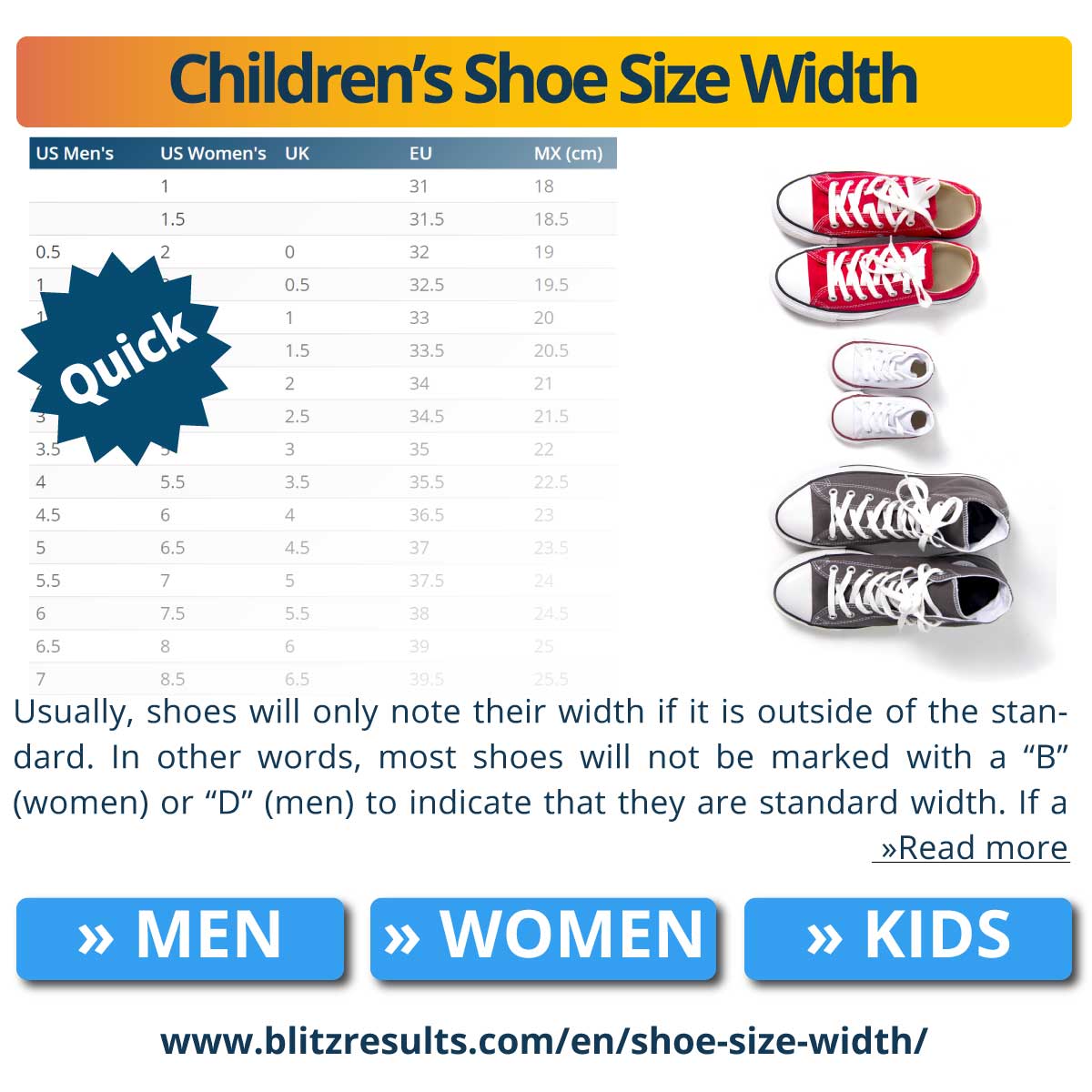
Children’s shoe size widths range from medium/average to extra-wide. Use this conversion chart to find the right size.
Children’s Shoe Size Letters
| Letter | Width | Abbreviation |
|---|---|---|
| M | Medium or Average | M |
| W | Wide | W |
| XW | Extra-Wide | WW or XW or EW |
What Is The Average Shoe Width?
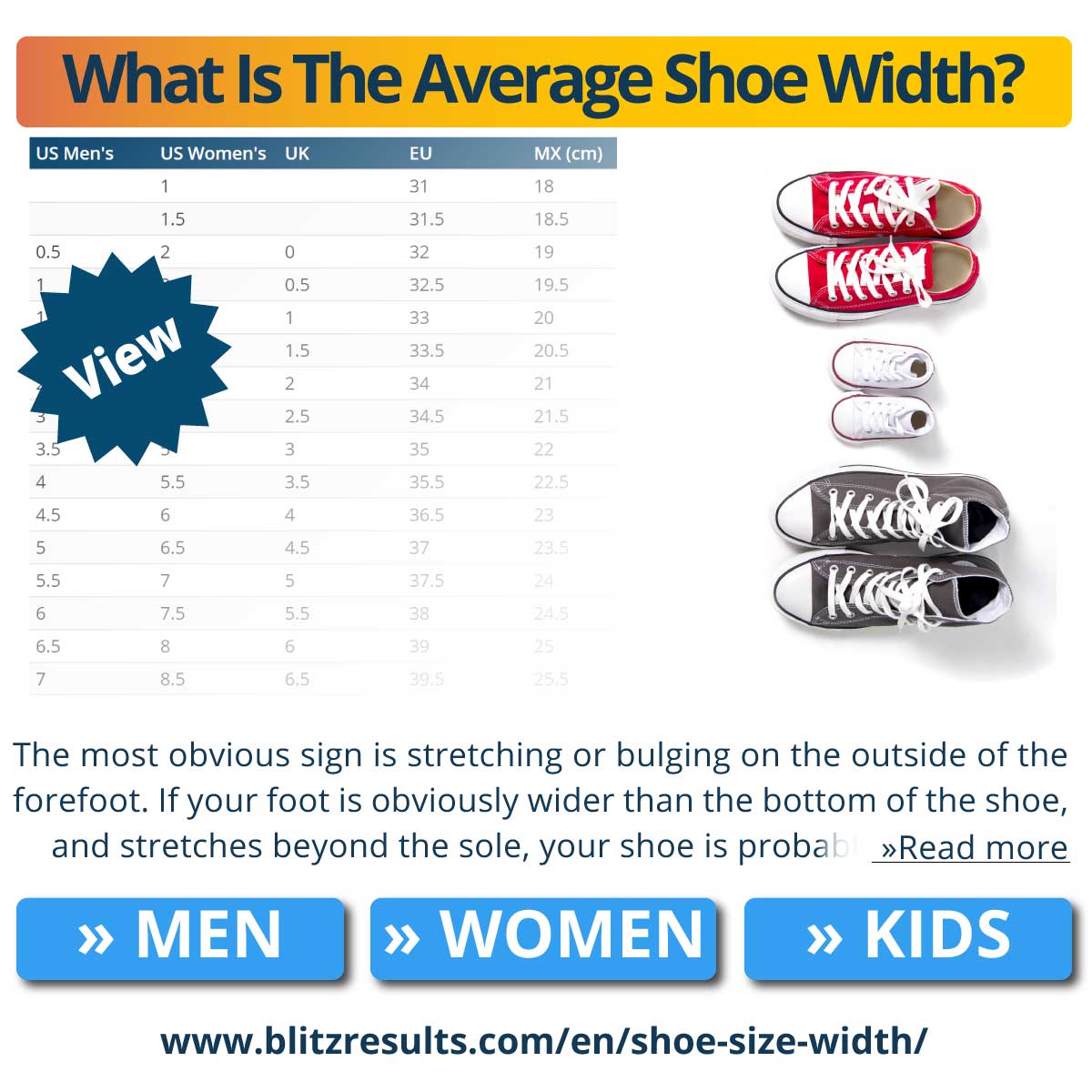
About 90% of the popular is of a “normal” width. That means that if you’re not sure of your foot width, you probably wear a normal width shoe, which would be a “B” for women and a “D” for men.
Usually, shoes will only note their width if it is outside of the standard. In other words, most shoes will not be marked with a “B” (women) or “D” (men) to indicate that they are standard width. If a shoe is not marked with a width at all, it is probably a standard width.

However, non-standard widths will usually be identified on boxes, and within the shoes on the label that is underneath the tongue of the shoe.
How Can You Tell If You Need A Wider Shoe?
The most obvious sign is stretching or bulging on the outside of the forefoot. If your foot is obviously wider than the bottom of the shoe, and stretches beyond the sole, your shoe is probably too narrow.
Most running and training shoes can be purchased in a variety of widths. In addition, men may choose to purchase women’s styles to achieve a narrower fit, and women can purchase men’s shoes to get a wider fit.
Does Foot Width Change Over Time?
Yes. Your foot can get wider even when you stop growing. This can happen if you gain weight or are retaining excess water. Diabetes and pregnancy can also affect foot size.
Foot size usually increases as your weight increases, and can decrease when you lose weight, or your insulin resistance is eliminated.
Do All Shoe Brands Come In Width?
No. Most European brands have only standard widths. Many US brands also do not issue wide or narrow-width shoes, though many manufacturers have begun offering more options in the last 20-30 years.
What Happens If My Shoes Are Too Narrow?
Narrow shoes can lead to a variety of health issues, like infected foot sores, foot deformities, hammertoes, and bunions. Cramps and excessive sweating, which can lead to bacterial or fungal infections, is also a common issue.
What Happens If My Shoes Are Too Wide?
Your shoe will not be snug, and will rub against the back of your heel, resulting in a callus or even a bone spur. You also won’t feel as stable when you walk, and your feet will move around in your shoes, which can cause friction when walking, leading to sores and blisters. Nail problems and hammertoes are also common issues with overly-wide shoes.
Do I Need A Wider Shoe If My Foot Is Bigger?
The answer is “yes, but not always.” Usually, larger shoes will be somewhat wider than smaller sizes – the shoe will remain proportional. For example, a size 9D men’s shoe will be narrower than a size 13D men’s shoe, because a size 13 shoe is bigger, overall.
However, we do not recommend choosing a larger shoe size just to get a wider fit – this can cause tripping hazards and other such issues. Make sure you choose a size that fits both the length and width of your fit properly.
What are average show widths?
For men, a D width is considered to be medium or “average.” For women, a B width is considered to be medium.
Insights from our Lab
This is how we work: watch the video and see how we measure and research in our lab.
- 1 UK Shoe Width Chart
- 2 How To Measure Shoe Width Yourself
- 3 Men’s Shoe Width Chart
- 4 Men’s Shoe Size Letters
- 5 Women’s Shoe Width Chart
- 6 Women’s Shoe Size Letters
- 7 Children’s Shoe Size Width
- 8 Children’s Shoe Size Letters
- 9 What Is The Average Shoe Width?
- 10 How Can You Tell If You Need A Wider Shoe?
- 11 Does Foot Width Change Over Time?
- 12 Do All Shoe Brands Come In Width?
- 13 What Happens If My Shoes Are Too Narrow?
- 14 What Happens If My Shoes Are Too Wide?
- 15 Do I Need A Wider Shoe If My Foot Is Bigger?
- 16 Insights from our Lab
